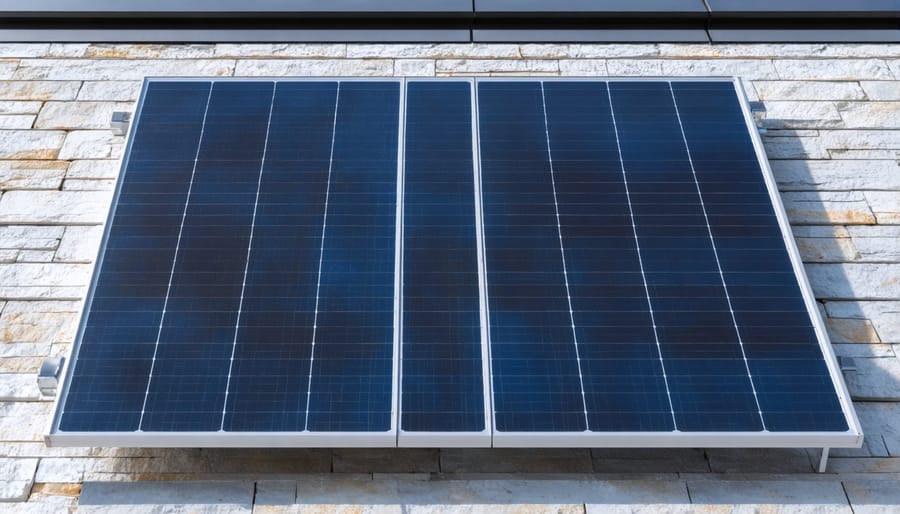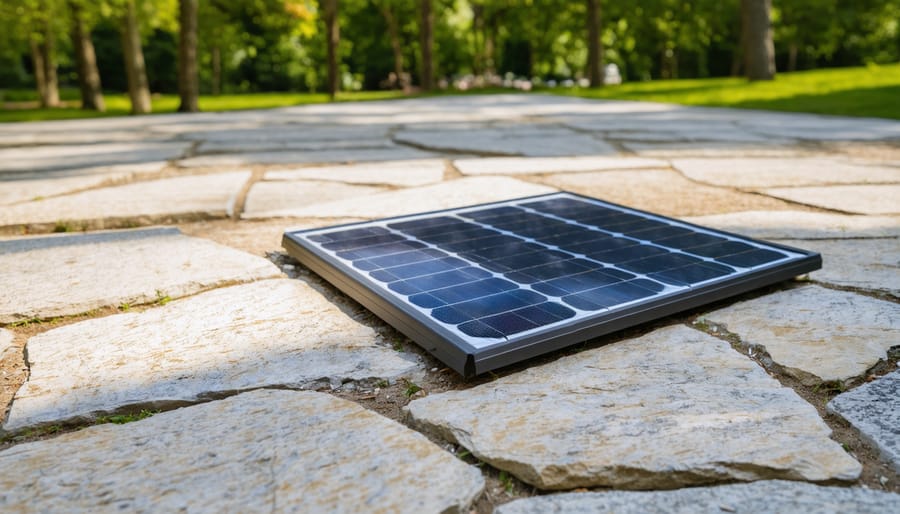Solar-powered stone installations merge ancient materials with cutting-edge renewable technology, creating sustainable landmarks that transform ordinary landscapes into educational centerpieces. These innovative structures harness sunlight through strategically placed photovoltaic cells, seamlessly integrated into natural stone formations to power lighting, water features, and interactive displays while maintaining their organic aesthetic.
Beyond their architectural appeal, these installations serve as living laboratories, demonstrating renewable energy principles in action. Students and visitors can observe real-time energy generation, storage, and consumption through embedded monitoring systems, while the weathered textures and natural patterns of stone provide a striking contrast to modern solar technology.
From university campuses to public parks, solar-powered stone installations are revolutionizing how we think about sustainable design and educational spaces. These self-sufficient structures reduce energy costs while creating engaging outdoor learning environments that inspire future generations to embrace clean energy solutions. Their durability and minimal maintenance requirements make them practical investments for institutions committed to both environmental stewardship and experiential learning.
How Solar-Powered Stone Features Work
Solar Collection Systems
Modern solar collection systems integrated into stone installations combine sophisticated photovoltaic technology with natural stone’s inherent thermal properties. The latest solar-enhanced stone technology typically employs thin-film solar panels or crystalline modules that can be seamlessly incorporated into stone surfaces without compromising their aesthetic appeal.
These systems typically include three main components: the photovoltaic elements, power conversion equipment, and energy storage solutions. The solar collectors are strategically positioned to maximize sun exposure while maintaining the installation’s design integrity. Advanced micro-inverters or power optimizers convert the collected DC power to usable AC electricity, while lithium-ion battery banks store excess energy for use during non-daylight hours.
Integration methods vary based on the stone type and installation purpose. Some systems utilize direct mounting techniques with specialized brackets, while others employ innovative lamination processes that bond solar elements directly to the stone surface. Modern installations often feature smart monitoring systems that track energy production and consumption, allowing for optimal performance management and real-time adjustments.

Stone Selection and Preparation
The success of solar-powered stone installations begins with proper stone selection and preparation. Choose stones with flat or slightly textured surfaces that can effectively capture and reflect sunlight. Granite, slate, and limestone are excellent options due to their durability and thermal properties. Look for stones with darker colors, as they absorb more solar energy and provide better heat retention.
When preparing stones, ensure they are clean and free from debris. Stones should be cut to uniform thickness, typically between 2 to 4 inches, to maintain consistent heat distribution. The surface should be slightly roughened to improve solar absorption while maintaining aesthetic appeal. Consider the stone’s porosity, as highly porous stones may require sealing to prevent moisture damage.
Before installation, test each stone’s thermal conductivity and structural integrity. Arrange stones to maximize sun exposure during peak hours, typically facing south in the Northern Hemisphere. Create a stable base layer using crushed stone or gravel to ensure proper drainage and prevent settling.
Popular Solar Stone Applications
Illuminated Pathway Markers
Illuminated pathway markers combine the timeless beauty of natural stone with efficient solar technology, creating both functional and decorative landscape elements. Like solar gate openers, these installations harness sunlight during the day to provide reliable illumination at night. Each marker typically features embedded photovoltaic cells, LED lights, and rechargeable batteries, seamlessly integrated into carefully selected stone pieces.
These eco-friendly lighting solutions come in various stone types, including granite, slate, and limestone, offering design flexibility while maintaining durability. The markers automatically activate at dusk, providing up to 8-10 hours of gentle illumination that enhances safety and ambiance without compromising the natural aesthetic of outdoor spaces.
Installation requires minimal ground preparation and no complex wiring, making them an ideal choice for both residential pathways and commercial landscapes. The solar components are weather-resistant and designed to withstand various environmental conditions, ensuring long-term performance with minimal maintenance requirements.

Solar Stone Water Features
Solar-powered stone water features combine the timeless beauty of natural stone with sustainable energy technology. These installations harness sunlight through photovoltaic panels to power water pumps, creating soothing water movements without increasing electricity costs or requiring complex wiring installations.
Popular designs include cascading stone fountains, bubbling rock formations, and meandering stream beds. The solar components typically consist of a panel, pump, and battery storage system, allowing the feature to operate even during cloudy periods or after sunset. Modern systems can power flows ranging from gentle trickles to dramatic waterfalls, depending on the installation size and pump capacity.
Key advantages include flexibility in placement, as these features don’t require proximity to electrical outlets, and reduced environmental impact through clean energy use. Installation considerations should account for optimal sun exposure, water circulation patterns, and stone selection for maximum visual impact and durability.
Maintenance requirements are relatively minimal, focusing primarily on keeping solar panels clean, monitoring water levels, and performing routine stone cleaning to prevent mineral buildup. During winter months, many systems can be easily winterized to protect both the stone elements and solar components from freeze damage.

Educational Display Installations
Educational stone installations harness solar power to create engaging learning environments that demonstrate renewable energy principles in action. These interactive features typically incorporate photovoltaic panels seamlessly integrated with natural stone elements, creating functional exhibits that teach visitors about solar energy conversion.
Popular installations include solar-powered sundials carved from granite, which combine ancient timekeeping methods with modern solar technology. Water features powered by solar energy showcase how stored energy can drive pumps and create movement, while illuminated stone pathways demonstrate solar-to-electric conversion through LED lighting systems.
These installations often include information panels etched into stone surfaces, explaining key concepts like photovoltaic effects, energy storage, and sustainability. Some advanced displays feature digital monitoring systems embedded within stone pillars, allowing visitors to track real-time energy production and usage data.
Educational institutions particularly benefit from these installations, as they provide hands-on learning opportunities for students studying environmental science, engineering, and sustainable design. The durability of natural stone ensures these teaching tools remain functional for decades while requiring minimal maintenance.
Museums and public spaces increasingly incorporate these features into their landscapes, creating outdoor classrooms that blend aesthetic appeal with practical education about renewable energy solutions.
Installation and Maintenance
Professional Installation Tips
For optimal performance of solar-powered stone installations, proper placement and setup are crucial. Begin by conducting a thorough site analysis to determine the best location, ensuring maximum sun exposure throughout the day. The ideal positioning typically faces south in the Northern Hemisphere, with minimal shade obstruction from trees or structures.
When installing the solar panels, maintain a 30-45 degree angle for optimal sunlight collection. Use high-quality mounting brackets specifically designed for stone surfaces, and ensure all electrical connections are properly weatherproofed. Consider incorporating smart stone sensor integration to monitor power generation and consumption levels.
Foundation preparation is essential. Create a stable, level base using crushed stone or concrete, allowing proper drainage to prevent water accumulation. Install waterproof conduits for all electrical wiring, keeping them concealed yet accessible for maintenance. Use marine-grade wiring and connections to ensure longevity in outdoor conditions.
For lighting features, calculate power requirements carefully and include a battery backup system sized appropriately for your needs. Install an automatic shut-off mechanism to prevent battery drain during extended periods of low light. Finally, test all components thoroughly before completing the installation, and document the system layout for future reference and maintenance purposes.
Remember to check local building codes and obtain necessary permits before beginning installation. Professional electrician consultation is recommended for complex systems to ensure safety and compliance with regulations.
Long-term Care Guidelines
Regular maintenance is crucial for ensuring the longevity and optimal performance of solar-powered stone installations. Clean the solar panels quarterly using a soft cloth and mild soap solution to remove dust, debris, and bird droppings that can reduce energy absorption. Inspect the wiring connections annually for signs of wear or damage, and ensure all weatherproof seals remain intact.
Monitor the stone surfaces for any signs of weathering or discoloration. Apply an appropriate stone sealer every 2-3 years to protect against moisture damage and maintain the installation’s aesthetic appeal. Check that drainage channels around the installation remain clear to prevent water accumulation that could compromise the electrical components.
If you notice decreased lighting performance, first verify that the solar panels are clean and unobstructed. Check that the batteries are functioning correctly and replace them according to the manufacturer’s recommendations, typically every 3-5 years. LED fixtures should last 50,000+ hours but may need replacement if they show signs of dimming or inconsistent operation.
During winter months, remove snow accumulation from solar panels promptly to maintain charging capability. In areas with heavy leaf fall, implement more frequent cleaning during autumn. Keep surrounding vegetation trimmed to prevent shading of the solar panels. Document all maintenance activities and keep a log of any performance issues to help identify patterns that may require professional attention.
Environmental Benefits and ROI
Solar-powered stone installations offer substantial environmental benefits while providing impressive financial returns over time. These innovative features combine the timeless appeal of natural stone with sustainable energy technology, creating a harmonious blend of aesthetics and ecological responsibility.
From an environmental perspective, these installations significantly reduce carbon footprints by harnessing solar energy for illumination and water features. A typical solar-powered stone installation can save approximately 1,000 kilowatt-hours of electricity annually, equivalent to preventing half a ton of CO2 emissions. The systems require minimal grid electricity, operating primarily on renewable energy stored in high-capacity batteries.
The ROI of solar stone features becomes evident within 3-5 years of installation. While initial costs may be higher than traditional electrical systems, the elimination of monthly utility expenses and reduced maintenance requirements offset the investment. Property owners typically report energy savings of 60-80% compared to conventional lighting and water feature systems.
Additional cost benefits include:
– Federal and state tax incentives for solar installations
– Increased property value (typically 4-6%)
– Reduced landscaping maintenance costs
– Lower insurance premiums due to improved safety features
The durability of natural stone combined with modern solar technology creates a long-lasting installation that can function effectively for 20-25 years with proper maintenance. Solar panels maintain 80% efficiency even after two decades, while the stone elements can last indefinitely with minimal care.
These installations also contribute to water conservation through efficient pumping systems and reduced evaporation in water features. Smart controls and automated systems optimize energy usage based on natural light availability and seasonal changes, further enhancing their environmental impact and cost-effectiveness.
Solar-powered stone installations represent an innovative fusion of natural materials and sustainable technology, offering both aesthetic appeal and practical functionality. By incorporating these features into landscapes and architectural designs, we can create engaging spaces that demonstrate renewable energy principles while preserving the timeless beauty of natural stone. The combination of solar technology with stone elements not only provides sustainable lighting and power solutions but also serves as a compelling educational tool for future generations. As we move toward a more sustainable future, these installations offer a perfect balance of form and function, making them an excellent investment for both private and public spaces. Consider implementing these eco-friendly features in your next project to contribute to environmental conservation while creating stunning, educational landscapes that will inspire and inform for years to come.










